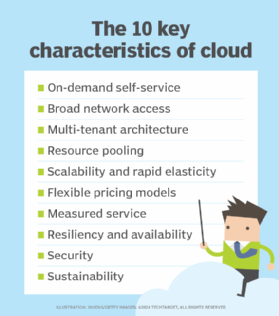10 key characteristics of cloud computing
Evaluate how these 10 characteristics of cloud computing, such as on-demand self-service and broad network access, can help you become a more nimble and cost-effective business.
Cloud computing remains a popular option for businesses of all sizes, driving its widespread adoption across the globe. It entails an ever-expanding list of tools and techniques, but the key cloud computing characteristics remain the same.
Cloud computing extends from infrastructure to SaaS models and everything in between, including AI, containers, serverless, databases, IoT, dedicated networking, analytics and business apps. Each subset has its own benefits and challenges, but several core cloud computing features continue to underpin all of them.
What is cloud computing and why is it important?
Cloud computing is a general term for the delivery of hosted computing services and IT resources over the internet. AWS was the first to popularize cloud computing as an alternative to on-premises infrastructure when it began selling computing resources and storage instances in 2006. Google and Microsoft followed soon after.
Cloud computing has become an indispensable technology for businesses of all sizes by offering scalability, flexibility and cost efficiency. With public cloud computing, businesses can make efficient economic decisions to avoid significant capital investment in hardware and infrastructure. Also, with minimal investment, companies have access to numerous cloud provider services, as well as advanced and cutting-edge technologies, such as generative AI and machine learning. Through global accessibility and enhanced collaboration, organizations can build a talented workforce that meets the demands of their industry and is not limited by the geographic location of an office.
The importance of cloud computing was especially demonstrated during the COVID-19 pandemic. Many companies rushed to adopt cloud technologies to accommodate a remote workforce. With the increased accessibility from cloud computing, teams were able to continue operations and access resources from anywhere, despite physical offices closing. Some businesses saw a spike in increased demand and were able to easily scale up their resources without physical infrastructure investment.
Cloud computing has become a linchpin to keep businesses nimble -- they can keep up with market trends, take advantage of the latest business innovations and stay competitive.

What are the essential characteristics of cloud computing?
Explore these 10 cloud computing characteristics that explain why it's the go-to destination for building and deploying modern applications.
1. On-demand self-service
AWS, Microsoft Azure, Google Cloud and other public cloud platforms make resources available to users at the click of a button or API call. With data centers all over the world, these vendors have vast amounts of compute and storage assets at the ready. This represents a radical departure for IT teams accustomed to an on-premises procurement process that can take months to complete. Cloud computing's characteristic of self-service provisioning goes hand in hand with on-demand computing capabilities. Instead of waiting for new servers to be delivered to a private data center, developers can select the resources and tools they need -- typically through a cloud provider's self-service portal -- and build right away. An admin sets policies to limit what IT and development teams can run, but within those guardrails, employees have the freedom to build, test and deploy apps as they see fit.
2. Broad network access
A big part of the cloud's utility is its ubiquity. Users can upload and access data from anywhere with an internet connection. Users can work from any location. The cloud is an attractive option for most enterprises that have a mix of OSes, platforms and devices. To preserve that broad network access, cloud providers monitor and ensure various metrics that reflect how customers access cloud resources and data such as latency, access time and data throughput. These factor into quality of service requirements and service-level agreements.
3. Multi-tenant architecture
Public cloud providers offer a multi-tenant architecture in which multiple users -- also referred to as tenants -- share the same physical infrastructure and use the same computing resources. While the platform and resources are shared, each tenant's data is isolated from others to ensure privacy and security. One of the main benefits of being a part of a multi-tenant architecture is affordability. Shared resources can reduce infrastructure and operational costs for the cloud service providers. Those savings can then be passed on to the tenants. Additionally, multi-tenant architectures can scale to house more tenants without significant changes to the underlying infrastructure.
4. Resource pooling
Public cloud providers rely on multi-tenant architectures to accommodate more users at the same time. Customers' workloads are abstracted from the hardware and underlying software, which serve multiple customers on the same host. Cloud providers increasingly rely on custom hardware and abstraction layers to improve security and speed up users' access to resources. With resource pooling, providers can achieve higher utilization rates and reduce waste.
5. Scalability and rapid elasticity
Resource pooling enables scalability for cloud providers and users, letting them add or remove compute, storage, networking and other assets as needed. This helps enterprise IT teams optimize their cloud-hosted workloads and avoid end-user bottlenecks. Clouds can scale vertically or horizontally, and service providers offer automation software to handle dynamic scaling for users. Traditional on-premises architectures can't scale as easily. Typically, enterprises have to purchase servers and other infrastructure assets to plan for peak capacity. Those extra resources sit idle during lulls in activity.
While scalability usually describes longer-term cloud infrastructure plans, rapid elasticity is a short-term characteristic. When demand unexpectedly surges, properly configured cloud applications and services instantly and automatically add resources to handle the load. When the demand abates, services return to original resource levels.
6. Flexible pricing models
This cloud computing characteristic shifts IT spending from Capex to Opex as providers offer per-second billing. A pay-per-use model achieves economies of scale through reducing costs on a large scale and seeing an increase in efficiency. Though this can generally be seen as a positive, IT teams must be careful since their resource needs likely aren't static. VMs should be right-sized, turned off while not in use or scaled down as conditions dictate. Otherwise, organizations waste money and can end up with sticker shock when the monthly bill arrives. This pricing model was once the only way to pay for cloud. But vendors have since added more flexible pricing plans that provide cheaper costs in exchange for longer-term commitments. This model is cost-effective since customers only pay for what they use.
7. Measured service
Measuring cloud service usage is useful for both a cloud provider and its customers. The provider and the customer monitor and report on the use of resources and services, such as VMs, storage, processing and bandwidth. That data is used to calculate the customer's consumption of cloud resources and feeds into the pay-per-use model. The cloud provider, meanwhile, can better understand how customers utilize its resources and potentially improve the infrastructure and cloud computing services offered.
8. Resiliency and availability
Cloud providers use several techniques to guard against downtime, such as minimizing regional dependencies to avoid single points of failure. Users can also extend their workloads across availability zones (AZs), which have redundant networks connecting multiple data centers in relatively close proximity. Some higher-level services automatically distribute workloads across AZs. Of course, these systems aren't foolproof. Outages occur, and enterprises must have contingency plans in place. For some, that means extending workloads across isolated regions or even different platforms -- though that can come with a hefty price tag and increased complexity.
9. Security
While many enterprises balked at migrating workloads because of security fears, those concerns have largely subsided, partly due to the benefits of the above characteristics of cloud computing. Cloud vendors employ some of the best security experts in the world and are better equipped to handle threats than most in-house IT teams. In fact, some of the biggest financial firms in the world say the cloud is a security asset. However, this doesn't absolve users of their duties. Public cloud providers follow the shared responsibility model. They tend to the security of the platform, and users handle their own apps that sit on top. Failure to fully grasp those delineations has led to high-profile exposures of sensitive corporate data in the past.
10. Sustainability
Cloud computing is considered a sustainable option. Cloud providers have increased their sustainability efforts to reduce their environmental impact by building more energy-efficient data centers and using renewable energy sources. Businesses that choose a public cloud option and share resources, instead of building their own physical data center, reduce their own physical infrastructure, which, in turn, leads to lower energy consumption. They can further their own sustainability goals through provider tools that can optimize supply chain logistics and track carbon emissions. Cloud computing also enables businesses to pursue a remote-friendly workforce, which reduces the need for physical meetings, further decreasing transportation-related emissions and resource consumption.
Editor's note: This article was updated to reflect the latest developments in cloud computing.
Trevor Jones and Johanna McDonald contributed to this article.
Kathleen Casey is site editor for TechTarget Cloud Computing. She plans and oversees the site and covers various cloud subjects, including infrastructure management, development and security.






